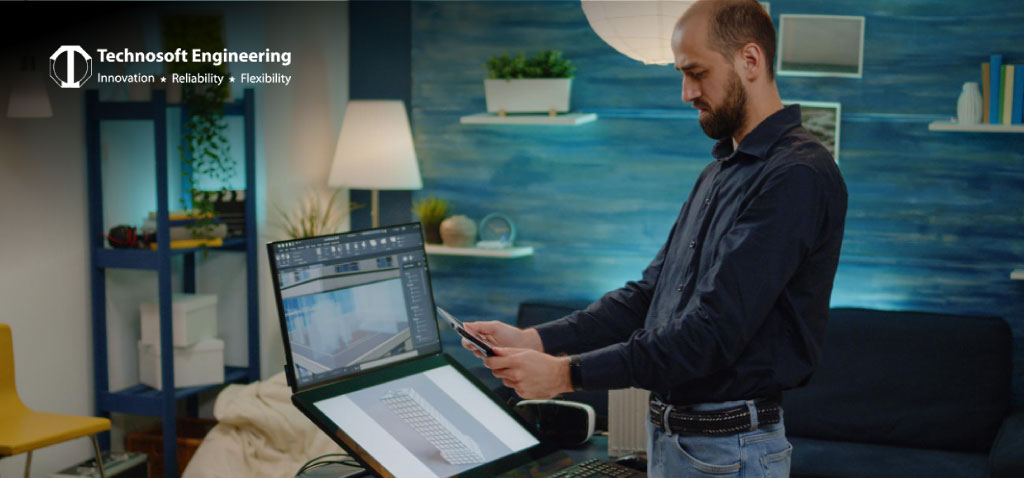
Table of Contents
- What is Computer Aided Engineering (CAE)?
- How does Computer Aided Engineering (CAE) work?
- Advantages of Computer Aided Engineering (CAE)
- Disadvantages of Computer Aided Engineering (CAE)
- Who Uses Computer Aided Engineering?
- What Industries Use CAE? for Industrial Applications?
- What Does A CAE Engineer Do?
- How Has Computer Aided Design Helped Engineers?
Key Takeaways
- Computer Aided Engineering Services (CAE) applies computational methods as well as simulations in engineering design, analysis, and optimization.
- This includes design optimization, simulation capabilities for various physical phenomena, cost and time savings, interdisciplinary integration, accuracy, and reliability.
- Using this technique results in improved product performance, reduced development costs, shorter time-to-market cycles, and better decision-making in engineering applications.
Today we are going to discuss computer aided engineering(CAE), which also refers to modern technology, which has revolutionized how engineering design, analysis, and optimization are done in the context of engineering processes as well as product development.
Unlike traditional approaches that depend heavily on the production of physical prototypes and subsequent iterative testing, this unique technology of CAE utilizes computer-based techniques and simulations to create a virtual environment in which engineers can explore, review, and improve their designs with remarkable accuracy and efficiency.
Computer aided engineering services, at its core, is an encompassing suite of software applications, algorithms, and modeling techniques that empower engineers to delve deep into their designs, exploring elements such as structural integrity, material properties, fluid dynamics, and even thermal behavior, among others.
As opposed to conducting actual experiments on these problems, complicated relationships among different phenomena could be analyzed using CAE, thus allowing an assessment of how different designs would work once they were implemented under normal conditions.
One major advantage of computer aided engineering is its capability to support design optimization. Engineers can make any number of changes to the design and evaluate it against various performance, transportation characteristics, parameters, and other considerations to ensure that they achieve the best possible results.
Such an iterative process within the computer-based domain greatly reduces the need for expensive physical models or extensive testing periods, thus limiting the expenditure involved during the manufacturing stage and reducing the entire cost of making new products.
Furthermore, computer aided engineering services facilitate interdisciplinary integration by integrating multiple engineering disciplines into one seamless platform. Engineers may then view a culmination of all aspects when designing their products, from the metals used to build them up to the forces acting upon them during operations until the end of their lifecycle.
In short words, CAE helps engineers break new ground in terms of innovation while promoting high-level creativity coupled with accuracy at every point when designing products. It uses computational capabilities drawn from CAE to produce solutions that meet today’s needs fully optimized.
- Design Optimisation: With this tool, various parameters are investigated along with their influence on performance and efficiency.
- Simulation Capabilities: It can be used to analyze such complex physical phenomena as fluid dynamics, structural mechanics, thermal behavior, electromagnetic properties, etc.
- Cost and Time Savings: By cutting out the need for a prototype or extensive use of testing, CAE has been able to reduce costs and hence save time in developing new products.
- Interdisciplinary Integration: Various engineering disciplines are integrated into one system through CAE, thus guaranteeing full examination and holistic design answerability.
- Accuracy and Reliability: The application of enhanced algorithms and models in CAE makes possible very accurate predictions that facilitate making decisions.
How does Computer Aided Engineering (CAE) work?
If you dive deep into it, computer aided engineering (CAE) is based on sophisticated computational techniques combined with simulations. Let’s take a close look at it:
-
Simulation modeling:
starts with creating intricate digital models that mirror the physical characteristics and behaviors of the engineering system or product under investigation. These typically include elements like material properties, geometric shapes or forms, structural components, and fluid features, among others.
-
Analysis through Algorithms:
These digital models are then subjected to advanced algorithms and mathematical models within the CAE software. In other words, these algorithms portray different scenarios and interactions that can predict how the product or system will behave when it is functioning under different working conditions.
-
Virtual Testing:
A wide range of virtual tests and simulations are performed by engineers using CAE, which include stress analysis, vibration testing, fluid flow simulation, heat transfer studies, and electromagnetic analyses, amongst others. By enabling a detailed examination of performance characteristics and other aspects of design behavior during the developmental stage, virtual testing helps engineers adjust and optimize the designs before any physical prototypes are made.
Advantages of Computer Aided Engineering (CAE)
-
Cost Savings:
This becomes possible due to CAE because lesser quantities for physical prototypes and vast amounts of testing material costs are significantly cut.
-
Time Efficiency:
The general product development timeline tends to be quicker as a result of streamlining the design and analysis stages using CAE. They can go through many designs quickly, identify problems at an early stage, and make informed decisions promptly, thus accelerating products’ time-to-market substantially.
-
Improved Accuracy:
Engineers carry out very precise simulations by employing CAE, which assists them in predicting and understanding the behavior of complex systems better. Better-informed design choices based on this accuracy lead to optimized performance levels and improved reliability.
Disadvantages of Computer Aided Engineering (CAE)
-
Complexity:
Mastering utilization tools like those associated with CAE requires specialized training and expertise. Simulation modeling as well as analysis intricacies may prove difficult for engineers who do not know much about these complex programs.
-
Computational Resources:
Sometimes performing complicated simulations with CAE requires significant computational resources like HPC systems, leading to longer simulation times or hardware resource addition needs.
Who Uses Computer Aided Engineering?
With the help of analytical approaches such as Computer Aided Engineering, it is common among engineers from various fields, including mechanical engineering, electrical engineering, civil engineering, aerospace engineering, and automotive engineering, among others. CAE is a common tool for professionals in designing, analysis, and optimisation tasks throughout many industries.
What Industries Use CAE? for Industrial Applications?
CAE has made significant progress in bridge and tunnel construction for buildings and automobile projects. For example, it can be used to analyze the structural integrity of a model bridge or evaluate whether a proposed tunnel would withstand anticipated seismic events.
What Does A CAE Engineer Do?
A person whose specialization lies in the use of computer aided analysis software programmes as well as techniques to analyze, simulate, and optimize engineering designs is known as a CAE engineer. He works with diverse teams so that design meets its performance requirements while taking into account safety standards and regulatory compliance.
How Has Computer Aided Design Helped Engineers?
Computer Aided Design (CAD) revolutionized the field of engineering, enabling engineers to create complex digital models for products and systems. The combination of CAD and CAE improves the accuracy of design, facilitates rapid prototyping, and enables efficient collaboration between different disciplines within engineering, thus enhancing innovation across various fields.
Closing Thoughts
In summary, modern-day technology cannot exist without computer aided engineering (CAE). Thus, it plays an important role in driving innovation, minimizing costs, accelerating the product development life cycle, and ensuring excellence in the field of engineering, among others. Moreover, this integration is going on, as can be seen from the increased relationship between CAE AI and ML across different industries; therefore, at least we can say that the future for this kind of practice looks promising, if not more innovative than what we have today.
At Technosoft engineering consulting services, our team of highly skilled engineers will bring their decades of experience and expertise to your project and ensure that we provide an accurate and precise solution for all your engineering needs.
We understand the importance of benefiting from high-end technologies such as computer aided engineering that help drive innovation, accelerate product development, and reduce costs at the same time.
By partnering with Technosoft for your engineering projects, we will help you overcome engineering challenges with personalized support and a collaborative approach to deliver your projects with the highest standard, quality, and efficiency.
Experience the difference with Technosoft. Connect with us today.



